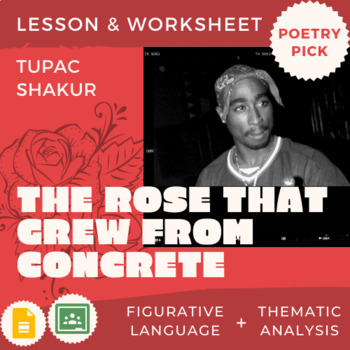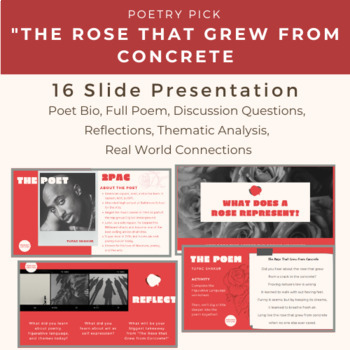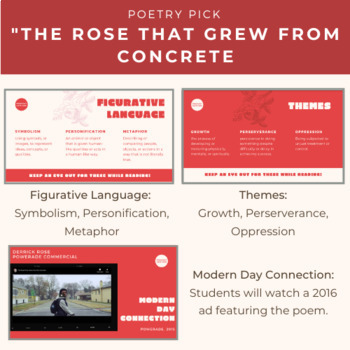Poetry Pick: "The Rose that Grew from Concrete" Lesson & Worksheet
- Zip
What educators are saying
Description
This fun poetry lesson will get students thinking about important concepts while also strengthening their poetry comprehension skills. Tupac Shakur's iconic poem explores powerful themes such as growth, perseverance, oppression, identity, racism, and artistic expression. In this lesson, students will analyze these themes alongside his use of figurative language to gain a better understanding of both the mechanics and craft of poetry. This poem is great for students of all ages because it is short and digestible while also being rich in figurative language such as symbolism, personification, and metaphor.
In this lesson, students will participate in a lecture of "The Rose that Grew from Concrete" that includes quotes, videos, discussion questions, and reflection questions. They will also complete a worksheet about figurative language that can be used as an exit ticket.
----------------------------------------------------------------------------------------------------------------------------
Learning Objectives:
- Students will be able to understand and identify figurative language in the poem "The Rose that Grew from Concrete" through oral and written responses.
- Students will be able to describe the role of symbolism, personification, and metaphors in the poem.
- Students will be able to draw connections between the poem and modern day media.
Activities:
- Lecture
- Figurative Language Worksheet
- Group Discussion
- Videos (2)
- Reflection Questions
- Can also be used as an Exit Ticket!
Included
You will receive one .zip file including the following:
Slides: The Rose that Grew from Concrete (PDF & Google Slides)
- 16 Slides
- About the Poet
- Quotes from the Poet
- Figurative Language
- Symbolism, Personification, Metaphor
- Themes
- Growth, Perseverance, Oppression
- Full Poem
- Video: "The Rose that Grew from Concrete" (30 sec)
- Video: "The Rose that Grew from Concrete" Powerade Ad (1 min)
- Discussion Questions
- Reflection Questions
Worksheet Activity: Figurative Language (PDF & Google Slides)
- Full Poem
- Annotation Instructions (Identifying Figurative Language)
- Short Answer Questions (2)
- Answer Key
Teacher Guide
- Product Description
- Google Slides Links
- Common Core Standards
- Learning Objectives
- Additional Background Resources
----------------------------------------------------------------------------------------------------------------
This text is a great example of activist writing. If you're looking for more activism content, check out my INTRODUCTION TO ACTIVIST WRITING for a powerful lesson & materials on this topic!
Looking for more classroom content related to music? Take a look at my MUSIC IS POETRY UNIT that includes high-interest poetry analysis of popular songs.
Check out my entire ENGLISH LANGUAGE ARTS COLLECTION!
VISIT MY STORE to view more intentional classroom décor, inclusive lessons & activities, and more!
Let's Connect!
Follow Pedagogy Café on Instagram





